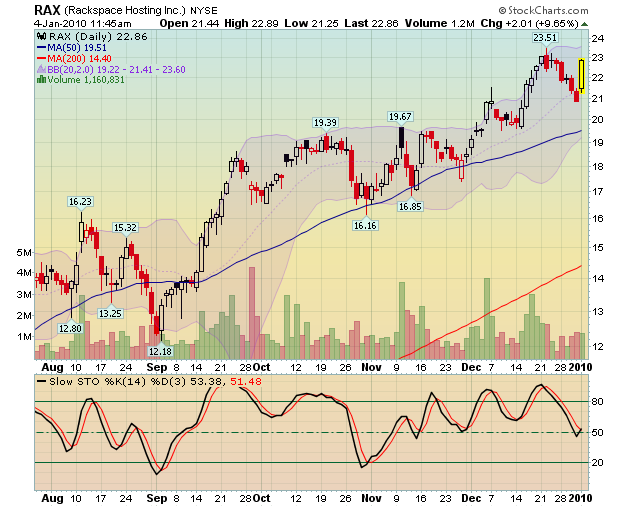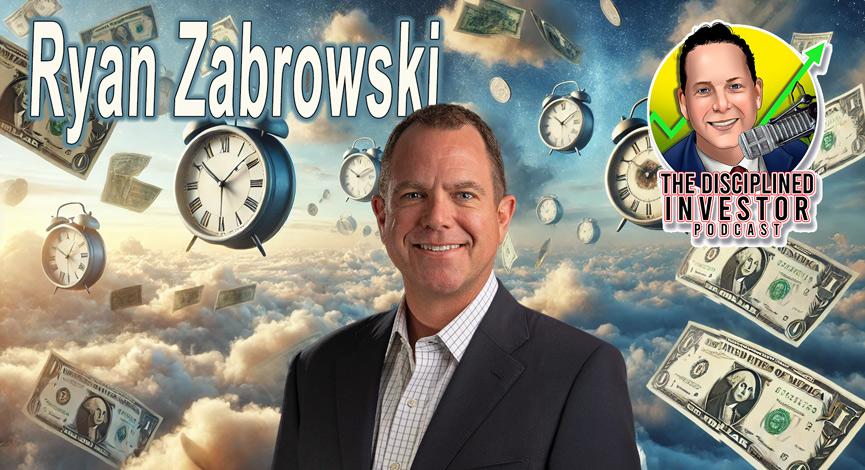A good story about a somewhat old story in Barron’s this weekend. The “Cloud” will be something to seriously contend with the author believes and cites a few companies that may see significant financial benefit from the upcoming mass-adoption.
Too bad that Rackspace (RAX) was left out as they are one of the key players in this space and up 10% on the day, perhaps as a result of this story. (Note: TDI Clients are long RAX)
Either way, we still believe that the fundamentals, growth opportunities and the technicals look good. This is a company that has a good plan and is in the sweet spot for a web service that is growing exponentially. Who would have ever thought that we would go back to a dumb-terminal again? Looks like we are moving in that direction…
From Barron’s:
“IF YOU DON’T HAVE A ‘CLOUD STORY,’ you better get one,” advises Riverbed Technology’s chief executive officer, Jerry Kennelly, echoing the importance — and hyperbole — accorded the Internet a decade ago. Kennelly’s storage and networking company could be a major beneficiary of the cloud trend that’s expected to transform computing over the next decade or so.
What exactly is cloud computing? Definitions vary wildly, but it is essentially the interconnection of computer-data centers via a network, usually the Internet. The cloud image is a tracing of Internet links that connect several different computer systems.
Table: Who’s Ahead in the Clouds?
You’re in the clouds when you access a photo from a social-networking Website like FaceBook or MySpace and store your pictures on the site, rather than on your hard drive. You’re also using cloud computing if you’re a small-business owner who decides to access his sales group’s customer-relationship programs via a Web browser from Salesforce.com (ticker: CRM) because he hates the hassle or expense of maintaining his own software applications. And if you’re a giant Barron’s 400 company that doesn’t want to invest in any more data-storage arrays and opts to store digital information with IBM-run (IBM) data centers, you’re again operating in the clouds.
“The notion of cloud is a technology architecture that cuts across every tech sub-sector,” says David Readerman, a senior investment analyst with Denver-based Marsico Capital Management.
Any ‘game-changing’ tech trend naturally draws skepticism (think sock puppet). Oracle CEO Larry Ellison joked sarcastically at a recent analysts’ meeting that cloud computing “is the future of all computing, but more impressively, it is the present of all computing and the past of all computing…Everything is cloud computing.” Adds Hewlett-Packard chief Mark Hurd: “If my chief technology officer came to me and said he wanted to put our own [internal] e-mail into the cloud, I would tell him to go back to his office and work on something else because of the privacy issues.”
That said, both of their companies are developing cloud stories because the benefits are so compelling, ranging from cost savings to added speed and flexibility to higher performance. From the cloud, computing power and other services can be accessed on demand, used as needed and paid for based on that usage, which can be way more efficient than owning racks of computers and stacks of software that seldom run at peak efficiency. Those benefits have looked even more attractive as companies search for new ways to save in a tough economy.
Eventually this could mean that companies would own fewer computers and have less need to make major enterprise-software investments. Although they’ll occur in steps over a decade or more, these changes are expected to remake technology as thoroughly as the Internet has — with, perhaps, a lot less destruction of investors’ assets.
THE MOVE TO THE CLOUD ALSO will produce winners and losers, though it’s much too early to handicap who they will be.
Investors, says Readerman, must decide what group within cloud computing they will concentrate on. They might, for example, want to focus on “arms merchants,” whose products help build clouds by enabling the consolidation of data centers. This group, which has already benefited from the advent of cloud computing, would include companies such as Riverbed (ticker: RVBD), 3PAR (PAR), and VMware (VMW). Or they could concentrate on companies that provide partial or complete information-technology infrastructures as a service, such as AT&T (T), Amazon.com (AMZN), Saavis (SVVS) or Terremark World (TMRK), says Readerman.
Major tech players like Google (GOOG), Apple (APPL) and Microsoft (MSFT) are all potential beneficiaries — or possibly losers. They’re each expected to enter one or more facets of cloud computing to keep pace with customer demand. One example: Apple’s recent purchase of Lala Media was said to have been prompted by its desire to let iTunes users purchase and manage their music without having to download software, a form of cloud computing that Lala already uses. There will be lots of other examples among products and services within both the consumer- and business-software sectors.
Barron’s recent cover story on the technology outlook (“Lunch Time!” Oct. 26) spotlighted the powerful consolidation going on in enterprise technology among major companies including Cisco Systems (CSCO), H-P, IBM (IBM), Dell (DELL) and Oracle, a group one executive refers to as “CHIDO.”
This merger and acquisition activity is largely in anticipation of cloud computing. As customers begin a huge push to shift the cost and operating responsibility of their computer-data centers and networks off into clouds, full-service providers hope to be the one-stop shops that can provide their clients with software, hardware and networking gear to build and manage their private clouds.
But it’s only a short-term strategy. If corporations eventually shift the majority of their computing and communications needs to the clouds, they will need fewer computers and less big-ticket software because they won’t be running proprietary data centers anymore. Cloud computing will change the habits of corporate technology customers to the point where the incumbent full-service companies will need to re-invent themselves.
“You are seeing a lot of defensive activity right now because their organic growth is gone,” says David Scott, chief executive officer of 3PAR, a maker of highly efficient data-storage systems that could be a key component in cloud computing. “They are trying to color their inorganic growth as preparation for the new world order,” he adds. Scott’s company was the subject of a positive story in the Dec. 28 issue of Barron’s (“3PAR: Doing More With Less”).
BECAUSE OF CONCERNS LIKE those voiced by Hurd (as well as security and effectiveness worries), this shift will occur in stages, emigrating first to what are known as private clouds and then on to public clouds over a period of years. A private cloud usually means the data centers are still owned by the corporate users and managed in-house. But they take advantage of cloud-enabling technologies such as the virtualization provided by VMware and the Internet. (Virtualization software lets one computer take the place of several machines by running more than one operating system — say both Windows and Linux — and automatically allocating resources where they’re needed to increase efficiency.) If a company uses a “public cloud,” this usually means that nearly all of its information-technology operations are outsourced and managed by a third party that owns clusters of data centers.
“With a private cloud, I can control some of the aspects that bother me about a public cloud, such as security or the system going down,” says Gary Matuszak, global chairman for KPMG’s information, communications and entertainment practices, who advises companies about tech.
Yet, as companies become more comfortable with private clouds, they’re expected to extend their reach over to public clouds, which is the bigger, longer-term trend. The federal government is expected to be one of the biggest customers of private-cloud computing, spending as much as $43 billion in IT infrastructure and operations over the next three years, says analyst Tom Bittman at tech-research outfit Gartner Group.
Gartner predicts that the overall cloud-services market will grow from $70.8 billion in 2010 to $88.8 billion in 2011, a roughly 25% gain, even as technology generally struggles to find new areas for expansion.
SOME COMPANIES ALREADY HAVE found success in the clouds. Among them, Salesforce.com is often cited as a pioneer. Instead of owning enterprise software, companies can pay a subscription fee for its CRM, or customer-relationship-management services (commonly referred to as “Software as a Service,” or SaaS), over the Internet. It’s very appealing to small- and medium-sized outfits that can’t afford to buy software, and very disruptive to enterprise-software providers like Oracle (which owns Salesforce’s more traditional customer-relationship software rival, Siebel) and German enterprise-software giant SAP (SAP).
“We have differentiated ourselves from other software companies,” says Salesforce’s chief executive, Marc Benioff, who describes rival SAP as “the anti-cloud,” because of its reliance on older software practices.
Salesforce’s revenue has grown from $310 million to $1.29 billion in the past five years, and the company is expected to report a profit of $80 million this year. Since going public in 2004, its shares have soared 567%.
Newer Web-generation dynamos like Salesforce, as well as accounting and resource-planning provider NetSuite (N), have an advantage in pursuing their portions of the cloud. But they will need to fend off more intense competition as time goes on. SAP, for instance, is expected to relaunch its own on-demand CRM service this year.
“The fact that they are early providers doesn’t guarantee their success. They don’t have a lock on it,” Bittman cautions. “I think this is going to be a food fight.”
While Salesforce focuses on a narrow, vertical market with its services, other tech companies like Amazon, AT&T and Terremark World want to become third-party providers of “Infrastructure as a Service,” or IaaS.
In this case, the user essentially rents out resources that might include data-center space, networking equipment or servers. Thousands of corporate customers, especially new software companies, rely on Amazon’s unit, Amazon Web Services, for all or part of their computing functions. Goldman Sachs reportedly outsources a large portion of its IT function to a private cloud managed by AT&T Global Services.
Microsoft’s Azure, Force.com (from Salesforce) and Google’s App Engine each offer different arrays of services. “Infrastructure as a service is the long-term play,” says 3PAR boss Scott.
What will all of this look like in 10 or 15 years? Scott likens the transition to the introduction of electricity, which took at least three decades to fully implement. In the beginning, companies owned their own coal-burning power plants. But they eventually switched to centralized utilities that let them buy electricity at lower prices. With the shared use of this power, cost came down and efficiency improved.
“The outcome of all of this will be very compatible yet very differentiated cloud options,” says Steve Herrod, chief technology officer for VMware, the server-virtualization-technology provider that’s majority owned by storage giant EMC (EMC). (Microsoft and its ally Citrix Systems (CTXS) also sell virtualization software.)
A company could own and operate its own data centers as private clouds. It could hire an outside tech outfit to build and manage this operation. Or it could keep some of its information technology private and outsource other functions to a public cloud or simply outsource the whole function to a public cloud.
However they ultimately align, the clouds clearly are gathering. The consolidation of data centers and the outsourcing of information technology will prevail over the long haul. Everyone wants to do more with less. Already, many of today’s most successful start-ups, such as SugarCRM, an open-source customer-relationship-management service, are designed specifically to operate on a cloud and therefore have inherent advantages. Among them: open and flexible operating systems based on technologies that incorporate virtualization software.
“The mandate to build a private cloud or to become more cloud-like has reached a fever pitch,” says Herrod, who says his company may eventually help customers connect their private clouds to public clouds.
While there are many different paths for the clouds to travel, says Herrod, “building new [proprietary corporate] data centers is just not going to happen.” That’s why everyone is going to need a cloud story shortly.
___
Disclosure: Horowitz & Company clients may hold positions of securities mentioned as of the date published.

















